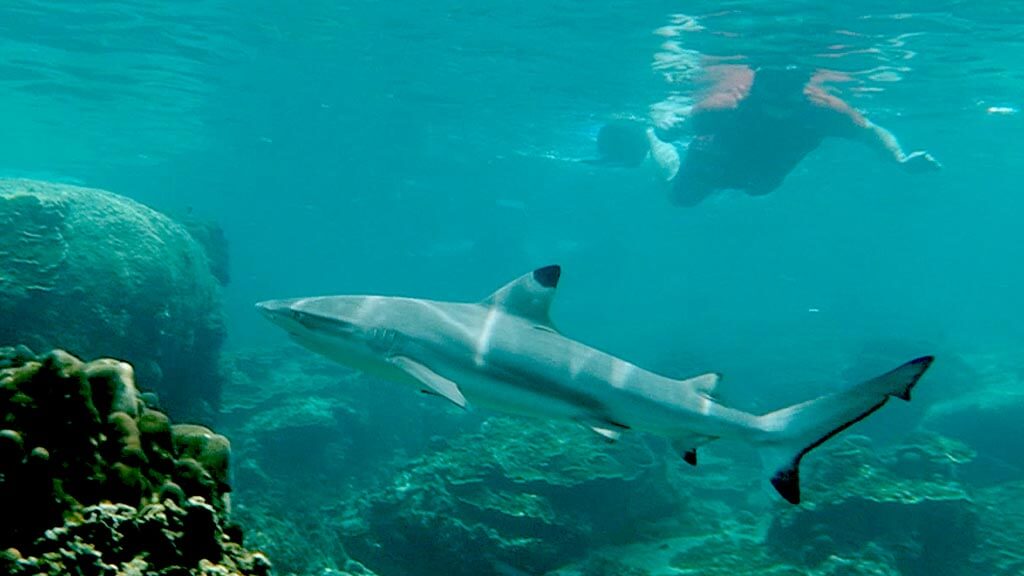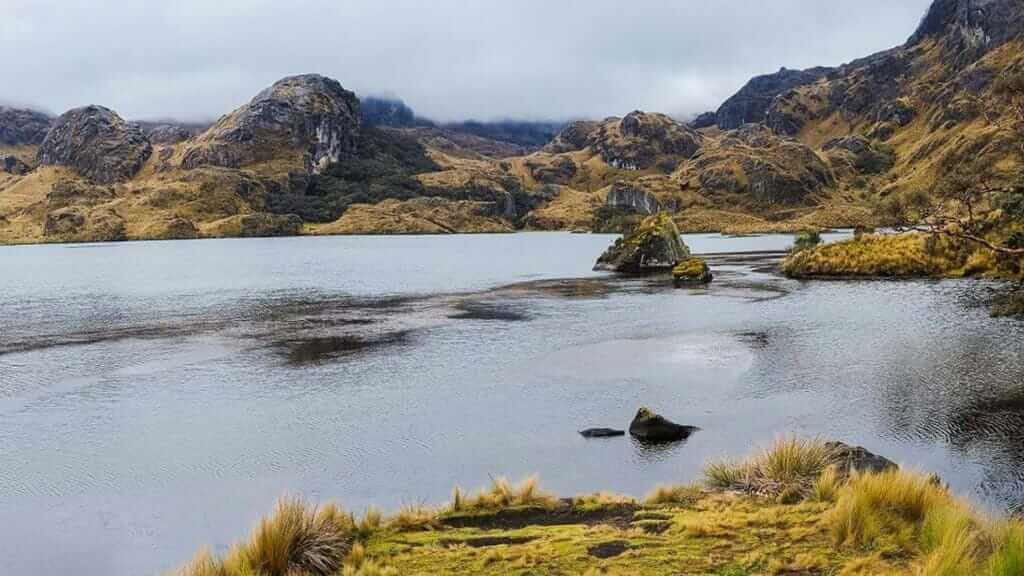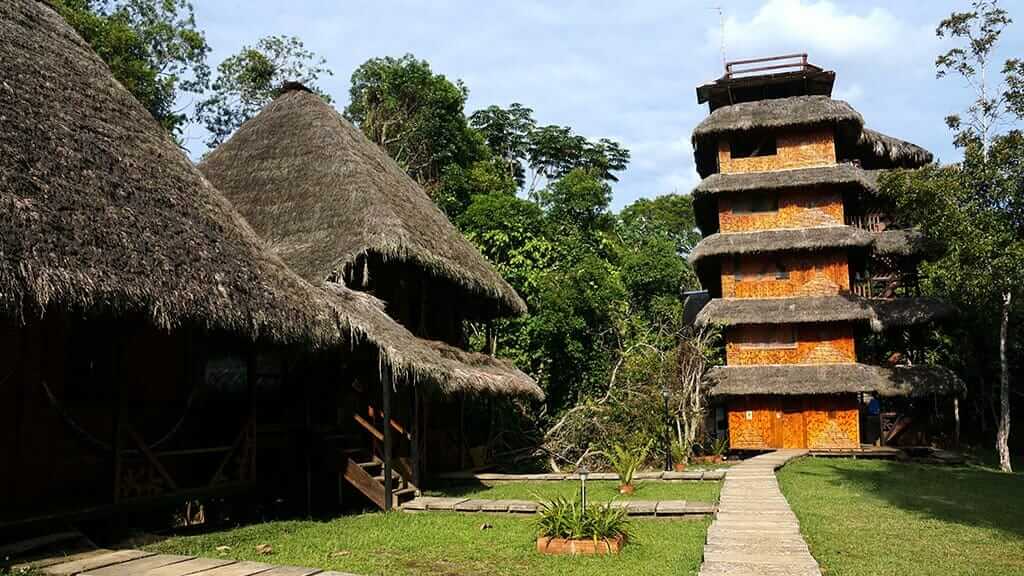Ecuador National Parks & Reserves
For nature lovers, there are few better countries to visit than Ecuador. With over 20 % of the land protected as a National Park or Nature Reserve, it’s a paradise for wildlife watching, nature conservation, and diversity of habitat.
Ecuador’s 36 national parks and reserves cover every region of the country, conserving rich biodiversity of flora & fauna, and protecting unique ecosystems for future generations to enjoy.
Above all, Ecuador National Parks promise both escape and adventure for intrepid visitors. There’s a whole world waiting to be discovered.
Up in the Andean Sierra, hikers can explore Andean volcanoes, high paramo plains, and mysterious cloud forests.
To the east, Ecuador’s Amazon Rainforest is a journey into a mysterious world of hidden secrets and unexpected adventures. Your very own Indiana Jones or David Attenborough experience.
On the coast, discover mangrove swamps, tropical dry forests, and white-sand beaches.
Last but not least, the Galapagos Islands & Marine Reserve need no introduction having played host to many famous Natgeo and BBC wildlife documentaries.
For a country the size of Wyoming, Ecuador packs a mighty punch. So, keep reading to discover our favorite 12 Reserves and National Parks in Ecuador.
SECURE YOUR ECUADOR TRAVEL
Get a FREE personalised quote today
How many National Parks are in Ecuador?
Ecuador may look like a small country on the map, but it more than makes up for it in terms of natural beauty and biodiversity.
In total, Ecuador boasts 11 national parks plus 25 nature reserves. These are divided across all 4 regions of the country: the Amazon Rainforest, Andean Highlands, The Coast & Lowlands, and the Galapagos Islands.

How to Visit Ecuador National Parks?
The good news is that all of Ecuador’s national parks and reserves are accessible and pretty easy to visit. The only challenge is deciding which ones to include in the limited time of your Ecuador travel itinerary.
So, what’s the best way to visit the national parks of Ecuador?
1. Self-organized Travel
It is possible to visit many Ecuador National Parks under your own steam, especially in the Andean highlands. You’ll have more freedom to explore at your own pace, and it’s kinder to your wallet.
A fun way to do this is with an all-terrain rental car and camping gear.
In some National Parks though it is required to travel with a local guide, for both safety reasons and to protect delicate habitats.
So, careful trip planning is required for adventurous souls looking to head out into the wilderness by themselves.

2. Ecuador National Park Tours
The popular alternative is to reserve national park tours.
From day trips to multi-day adventures, you’ll get to see the best highlights of each national park. You’ll also spot more wildlife, and learn about each habitat with a naturalist guide by your side.
Group tours operate to some of the more popular Ecuadorian national parks, from Quito, Guayaquil, and Cuenca. Or, private tours with your own guide offer a wonderful alternative, with more freedom and flexibility.
Contact us for a free tour quote – Happy Gringo specialize in custom-made trips right across Ecuador and the Galapagos. We’ll be happy to include a combination of Ecuador National Parks into the perfect vacation itinerary for you.

The Top 12 Reserves & National Parks in Ecuador
So, let’s get down to business.
Drum roll, please.
Keep reading for our top 12 favorite reserves & national parks in Ecuador.
We’ve tried to include something for everyone. Let us know if you agree with our selection.

1. Galapagos National Park & Marine Reserve
The Galapagos Islands are a huge tick for any travel bucket list. For many visitors, a Galapagos vacation is like stepping into your very own Discovery Channel documentary.
On land, a Galapagos Islands vacation is one of the most up-close and intimate wildlife encounters on the planet! Unique Galapagos birds & animals have little fear of humans and are happy to share their world with you.
Underwater Galapagos life is unbelievable too. Enjoy world-class scuba diving, & incredible snorkeling with sea lions, reef sharks, and penguins for company.
There´s also more to a Galapagos trip than just wildlife. There are more than enough jaw-dropping landscapes to make your friends jealous on Instagram. Imagine picture-perfect white sand beaches, and mysterious volcanic lava landscapes straight out of a Jurassic Park movie set.
Truly no other place on planet Earth is quite like the Galapagos. Prepare to have your expectations completely blown away!

The Galapagos Islands are the second largest marine reserve on the planet (after Australia's Great Barrier Reef), and an important protected haven for a host of endemic creatures. The impressive biodiversity of the Galapagos National Park has led to recognition by both UNESCO World Natural Heritage and Blue Park Awards.
There are different ways to visit the Galapagos Islands, something for every taste and budget. Live aboard Galapagos cruises cover more islands and visitor points in their itineraries. Galapagos Land Tours offer more freedom and flexibility to personalize your vacation. There are also specialist Galapagos Diving Trips and all-inclusive Galapagos Resorts.
Activities to enjoy include wildlife observation, trekking, snorkeling, kayaking, SUP paddle boards, and horse riding.
A visit to the Galapagos National Park is also educational. Experienced naturalist guides will explain all about the fascinating evolution of the endemic creatures you cross paths with, and the volcanic history of the archipelago.
For more information about how to visit, check out our detailed How to Visit Galapagos post.

2. Yasuni National Park
Recognized by scientists as the most biologically diverse place on the planet, Yasuni National Park represents a huge tick to any nature lover’s bucket list. For this reason, it’s a logical choice for #2 on our list.
Deep in Ecuador’s Amazon jungle region, just one hectare of Yasuní forest boasts as many as 650 different tree species. To put that into perspective, we are talking about more tree species than those found in the entire continent of North America!
It doesn’t stop there, the biodiversity statistics for mammals, birds, amphibians, plants, and micro-organisms are just as unbelievable. In fact, Yasuni National Park boasts a long list of biodiversity world records.

It therefore comes as little surprise that Yasuní Ecuador is recognized by both UNESCO and NATGEO as one of the top places in the world to visit for wildlife and nature.
There’s no shortage of activities to enjoy in the Amazon. Most organized rainforest lodge tours include wildlife and bird watching, canoe rides to explore, canopy observation towers, forest trekking, native community visits, nocturnal safari, parrot clay licks, and much more besides.
There are 2 excellent lodge choices for overnight stays within Yasuni: Napo Wildlife Center and Mandari Panga Camp. All other Ecuador jungle lodges are located just outside of the national park.

3. Cotopaxi National Park
Cotopaxi Volcano is THE iconic peak of Ecuador’s Andes. Like Mount Fuji in Japan, there’s something about the perfectly symmetrical snow-capped cone that catches the eye and imagination.
Ecuador’s Cotopaxi National Park protects an area of 128.9 square miles (333.9 sq km) of high Andean Paramo habitat. It might be cold up here at 4,000 meters above sea level, but that doesn’t stop an impressive list of local fauna calling the national park home. Deer, llamas, wild horses, and rabbits are common sightings. Andean foxes, condors, and owls also roam these lands.
Cotopaxi’s 5,897m (19,347 ft) peak has lured climbing enthusiasts for centuries, and the surrounding parkland is also great for adventure. Trekking, mountain biking, and horse riding all offer great ways to enjoy and explore the park.
Just 50 km (31 miles) south of the capital city Quito, Cotopaxi is also one of the most accessible Ecuador national parks for visitors.

4. Choco Andino Biosphere Reserve
Ecuador’s Choco Andino is a UNESCO-recognized biosphere reserve. This area protects pre-montane cloud forests and is considered a biodiversity hotspot of importance for bird diversity.
Ecuador’s Choco Reserve has been in the news of late for all the right reasons. In 2023, inhabitants of Pichincha Province voted to protect the Choco Andino habitat from future mining projects. That’s a big win for environmentalists in Ecuador and for tourists too.
So, what exactly is Cloud Forest?
Also known as Pre-montane forest, it’s an unusual habitat located on the slopes of the Andes mountain range. Cloud forest differs from the rainforest in that it is at higher altitudes (from 900m up to 2500m), and on sloped terrain. This creates a humid, mossy, dense jungle-like habitat that is mega-diverse in plant, bird, and animal species. While cloud forest trees are not as tall as in the Amazon, they are covered in rich mosses, bromeliads, orchids, and other epiphytes.

As the name would suggest, cloud forests are often shrouded in atmospheric mist and cloud, caused by condensation of moisture in the mountains. The result is a magical, other-worldly environment that almost feels out of a fairytale. One almost expects to cross paths with pixies or trolls in these woods.
Visitors to Ecuador’s Choco Andino Reserve can expect immersion in pure nature. Birds, butterflies, and orchids are high on the wish list of most tourists. The forest is also home to mammals including spectacled bear, olinguito, kinkajou, puma, and more.
Located within a 90-minute drive from Quito city, it’s possible to visit the Andean Choco as part of a day tour. Far better though is to plan a 2- or 3-day trip to explore this wonderful reserve in depth, and fully unwind & relax with the sounds of nature.
There are numerous excellent cloud forest lodges in and around the Choco Andino. Check out Bellavista, Maquipucuna, Sachatamia, and award-winning Mashpi Lodge for ideas.
For more serious birders we highly recommend Happy Gringo’s 4-day and 8-day Choco-Andino specialist birding itineraries. Our experienced birding guide will take you to all of the top spots in the Choco Andino to find your target birds.

5. El Cajas National Park
El Cajas National Park is one of Ecuador’s best-kept secrets, in the south of the country, close to Cuenca city. This Lake District of Ecuador is home to stunning glacial valleys, moors, forests, and a network of pristine mountain lakes.
There’s fairytale magic here, like the natural set of a Lord of the Rings movie. But you’ll find no hobbits, instead keep your eyes open for Andean Condors, Andean bears, hummingbirds, and wild alpaca.

El Cajas National Park is a place of water. A network of 786 lakes, lagoons & ponds is connected by crystal-clear streams. A carpet of sponge-like plants absorbs rainwater, releasing it slowly over weeks and months. Frequent rains and moist cloud cover ensure the cycle continues.
From water springs life. The moors and cloud forests are teeming with mammals, birds, and unusual flora to discover.
We recommend exploring El Cajas National Park using the network of trekking trails. At elevations of up to 4450m the weather is best described as changeable, so come prepared with rain gear and warm clothes.
It’s also possible to organize a guided day tour to Cajas from Cuenca.

GET FREE ADVICE
From an Ecuador destination expert today6. Machalilla National Park
On the coast of Ecuador, Manabi province is home to the fabulous Machalilla National Park.
Here, visitors are treated to something rather different from the other Ecuador National Parks on our list. Machalilla habitats include stunning beaches, dry forests, fog forests, and two islands to explore.
Machalilla National Park is famous as the best place in Ecuador for whale watching. Every year, between June and September, humpback whales visit Ecuador’s Pacific coast to mate. Boat trips take tourists out onto the ocean to enjoy the spectacle, as males leap acrobatically from the water.

On land, Isla de la Plata tours visit important nesting areas for birds including blue-footed boobies, Nazca boobies, and sometimes waved albatross. For this reason, the island is sometimes known as the Poor Man’s Galapagos, and it’s even rumored to hide a large horde of silver from Sir Francis Drake.
Other tourist areas to explore in Machalilla include the golden sands of Los Frailes Beach, the archeological site of Agua Blanca, and the El Rocio Eco Trail.
The most popular base from which to visit Machalilla National Park is Puerto Lopez town to the south. From here it’s relatively easy to reserve day tours with local travel agencies.
Alternatively, pre-book Happy Gringo’s 3-day Highlights of Machalilla tour, which includes guided visits to the best sites of the National Park, and free time to relax on the beach.

7. Antisana Ecological Reserve
Antisana Reserve is often overlooked by Ecuador tour groups who prefer to head to Cotopaxi. So, to escape the crowds, why not head off the beaten path to Antisana? Midweek you’ll often have the park almost to yourselves.
For outdoors lovers, this rugged Andean paramo landscape is the perfect playground. On clear days, visitors can enjoy spectacular views of the snow-capped Antisana volcano.

The biggest draw to Antisana, though, is the wildlife. This is the best place in the country to spot the elusive Andean Condor. These magnificent birds nest high on the cliffs of this Ecuadorian National Park. Up to 40 individual Andean Condors have been registered here, which is over 25% of the estimated population of wild Condors in all of Ecuador.
The best close-up views of condors can be enjoyed in the nearby Chakana Reserve (Antisanilla). This can also be a great spot for observing Andean Spectacled Bears in the wild, although a little luck is always required.
Bird watchers can also expect to tick off species of hummingbirds, including both the Giant and Sword-billed hummingbirds. Lake Micona is also home to a variety of Andean ducks and waders.
There is no public transport into Antisana National Park, so a pre-organized Antisana day tour or private transport is the only way to go.

8. Cuyabeno Wildlife Reserve
Ready to embark on a wild adventure deep into the heart of the Amazon Rainforest? Well, don your explorer's hat because we're about to dive headfirst into the lush paradise of the Cuyabeno Wildlife Reserve.
Not only is Cuyabeno Ecuador one of the most popular regions of the Amazon to visit, but it’s also accessible and affordable.
At Cuyabeno, pristine nature awaits the intrepid visitor. The incredible biodiversity of birds, animals, and plant species is hard to beat, including the famous Cuyabeno pink river dolphin. You’ll also come face to face with colorful Indian tribes, and can chance your arm at piranha fishing!
So, what’s so unique about Cuyabeno Ecuador?
The Cuyabeno Reserve is different from any other area of the Amazon Rainforest in South America. Cuyabeno is a flooded Amazon Forest and the most extensive wetlands of Ecuador’s Amazon. Here, water replaces terra-firma, and rivers become narrow canals & streams that drain into swamps and large lagoons. The canoe is the only way to get around.

The flooded forest wetlands habitat is rare so close to the Andes. Usually, drainage in the Andean foothills prevents the development of swamps and lakes. Cuyabeno is home to dark-water rivers, often brown and black due to the presence of decomposing vegetal material.
Visitors to Cuyabeno Ecuador thus get a great combo. Firstly, access to a fairly unique jungle ecosystem not found in other parts. Secondly, the opportunity to spot some cool wildlife like the pink river dolphin, black caiman, anaconda, and piranha fish.
All-inclusive Cuyabeno Lodge tours are the most popular way to visit. Check out Caiman, Tapir, and Jamu lodges, all deep in the heart of the Cuyabeno Reserve.

9. Chimborazo Wildlife Reserve
Our next Ecuador National Park has a unique and surprising claim to fame. Chimborazo Volcano (the focal point of the reserve) is the furthest point from the center of the earth, and the closest point on earth to the sun.
How is this possible? Surely the peak of Mount Everest holds this record, right? Well, yes, and no. Indeed, Chimborazo doesn't even rank inside the top 100 peaks on the planet in height! But, with a helping hand from the earth’s equatorial bulge, Chimborazo beats Everest by 2.1 kilometers when measured from the center of the planet.

The volcano is also surrounded on all sides by protected parkland covering an area of almost 60,000 hectares, and home to herds of wild vicuña. What is a vicuña? Imagine a small, cute relative of llamas and alpacas. They have particularly fine wool, said to be softer and lighter than cashmere.
To visit Chimborazo Reserve, head to Riobamba city, some 235km south of the capital city Quito. From there you can book day tours or head in to explore with your own transport.
10. Podocarpus National Park
Our next Ecuador National Park, Podocarpus, is in the deep south of Loja and Zamora Chinchipe provinces.
Podocarpus National Park is known as the “Botanical Garden of America”, with over 40% of the 4000+ plant species being endemic to the area. Protected habitats include lower montane rain forests, cloud forests, and high-altitude elfin forests.
Podocarpus is also home to over 600 bird species, Andean bear, mountain tapir, and jaguar. Among these bird species, there are 81 different kinds of colorful tanager and 61 hummingbird species.
It’s possible to visit Podocarpus from the highland town of Loja, or Zamora in the rainforest. Either way, it’s highly recommended to hire a local naturalist guide to uncover some of the secrets that Podocarpus holds.
For serious birders, check out the excellent Copalinga Lodge at Zamora, or consider a longer all-inclusive Southern Ecuador Birding Itinerary.
11. El Angel Reserve
Heading up north towards Tulcan town and the Colombia border, El Angel is a unique nature reserve for those who like to venture further off of the beaten path.
El Angel Reserve was created to protect a rather unusual plant, the Frailejon. Their tall trunks with furry leaves on top look rather like triffids (for those who remember the horror movie in which huge plants take over the world). The surrounding hills are covered in eerily beautiful Frailejones, standing tall like an army of invaders.
Another fascinating plant to look out for in El Angel is the Polylepis Tree. Growing only up at high altitudes, with flakey, paper-like brown skin, Polylepis trees are wonderfully gnarled and twisted due to the harsh conditions. Many of the Polylepis found at El Angel have grown for over a thousand years.
Getting to El Angel Reserve is part of the challenge. Sporadic public transport reaches as far as La Libertad in Carchi Province, from where it’s possible to rent a driver to take you the final 13km into the park. Alternatively, take your own private transport or rental car to explore the area at leisure.

12. Pululahua Geobotanical Reserve
Pululahua is only one of two inhabited volcanic craters in the world. It’s also the only Geobotanical Reserve found in Ecuador.
From the moment visitors first gaze down from Pululahua lookout, it’s clear that this is no regular volcanic crater. Beneath the clouds and mist, lush vegetation and rich volcanic soil have attracted homesteads and farms. This vibrant area also attracts thousands of tourists each year to explore its natural wonders.
Pululahua is a Quichua word that means “cloud of water”. It was declared a geobotanical reserve because of its geological uniqueness, producing a diversity of birds, animals, insects, and plant life.
There are so many ways to explore Pululahua Crater, from horse riding to mountain biking, and trekking. A few highlights to check out include The Chivo Rock, Limestone Kilns, The Pondoña Hill, and El Mirador. It’s also a great place to practice landscape photography.

So, there you have our top 12 Ecuador National Parks (& Reserves). But, please don’t be constrained by our list, as there are plenty more areas to explore besides.
Some of the notable National Parks that didn’t quite make the cut include Llanganantes (close to Baños), Sangay, Yacuri, Cayambe-Coca (close to Papallacta), and Sumaco Napo-Galeras. There are also heaps more reserves to be found across the country, all worthy of receiving visitors.
Ecuador National Park Facts
What is the most famous park in Ecuador?
The Galapagos Islands surely take first prize, with Yasuni and Cuyabeno coming in joint second in representation of the Amazon Rainforest.

What is the largest national park in Ecuador?
Yasuni is the largest mainland national park in Ecuador, covering a total area of 3,793 square miles (9,824 sq km).
Galapagos National Park is the largest marine reserve in Ecuador, protecting an area of 51,352 square miles.

What is the smallest national park in Ecuador?
El Cajas is the smallest Ecuador National Park, clocking in with an area of 110 square miles (285 sq km).

What was the first national park in Ecuador?
Established in 1959, The Galapagos Islands were the first officially declared Ecuador national park.
The most recently recognized National Park in Ecuador is Yacuri, established in 2009.

What percentage of Ecuador is protected land?
Approximately 20 percent of Ecuador’s national territory is protected by law. This compares favorably to the USA (13%).

Book With The #1 Trusted
Ecuador Travel Agency
In conclusion, a visit to some of Ecuador’s National Parks & Reserves is a MUST for nature & wildlife lovers. Spectacular Ecuador National Parks cover very different habitats across the whole country, offering something for all tastes. The protection of over 20% of Ecuador’s land mass is great news for foreign and local tourists alike and promises to preserve these unique habitats for future generations to enjoy.






